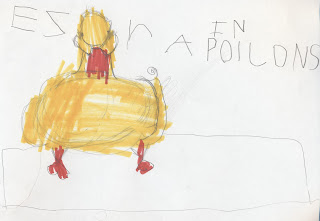Pretty. We've been going through Mona Brookes Drawing with Children, which represents a seismic shift in my art pedagogy philosophy. Shhh! She suggests teaching children how to draw things! She says it won't kill their native genius, but will give them skills to keep drawing as they grow.
You see, I never planned on teaching my kids how to draw, say--a duck, or a car, or a... anything. I thought kids would figure it out all on their own and giving them a method would somehow spoil the artist in them. But I saw some of my own kids drawing less, ironically, as their artistic eye improved. This kid was frustrated so much by a lack of technical drawing skills that the poor fastidious child didn't want to draw hardly at all.
When I was a kid I loved, loved, loved drawing. I remember that I liked to draw things I could draw well. First, I drew flowers and grass across the bottom of the page and a sun. Then I found a way to draw the sun into the corner and make a face on it. I drew houses and trees. Then I copied a house from a girl next to me in Miss De Vine's Kiddie Kollege (sic) who drew her houses sort of 3-D. I went through a phase where I thought I maybe wasn't so good at drawing and that made me pretty sad, but I was helped out of it by Ed Emberley of the thumbprint books, and various How To Draw books from the library, and Bob Ross, the happy tree guy who had a painting show on public television. I also had lessons in classical drawing, where I learned that the time-honored method for teaching art students is teaching them to copy masterpieces. Copying a line drawing, even a cartoon, develops skills that will carry over into life drawing. Brooke's book amply illustrates that what each student uses the techniques in unique ways, generating original works. Well, copying simple drawings might not be so crazy after all.

So Mona Brookes' approach really got me started on something. I found that the kids are hungry to learn to draw things. She also offers lots of helpful suggestions about teaching methods and attitudes to combat the paralysis of perfectionism! However, my kids are not crazy about the specific drawings in her lessons. It helps so much to have subject matter that they like! So I've been loosely using her method, but swapping the drawings for images that resonate with my kids. Like these ducks by Margaret Friskey.
Here are my sketches of the splishy, chubby duckies:
I was trying to figure out simple ways for the kids to get them. Basically, each duck is to circles; one for the head and one for the body, with other shapes added on. I do a step-by-step demo for the kids, describing exactly what I'm doing in terms of shapes. ("So now I'm going to draw a half-circle between the bottom corner of the beak and the head. That's the cheek. Then I do one on the other side")
Things I'm learning:
1. My kids have very exacting standards for themselves
2. Not being able to draw as clearly as you see is frustrating.
3. Keeping it short helps. One drawing is plenty. Brookes recommends warm-up exercises, which my kids enjoy very much, but we need a break! After just one drawing, they are bursting with tension! They run to the couch and throw all the pillows off for a friendly little war.
4. Drawing with my kids is so much fun!
Real: I borrowed Drawing with Children from a friend and immediately spilled water all over it, sigh. I bought a new copy for her.



















